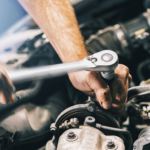Our guide to servicing your own car

You might think that servicing your own car is beyond you, but it’s actually well within the capabilities of almost all car owners. And with a full service costing between £100-£1000 (depending on your car), it’s definitely going to save you loads of cash!
Getting ready to service your car
You can’t service your car without some tools, and if you don’t already have a basic set of mechanics tools it’s well worth the investment. We’ve covered everything you need in this post, so check it out and start building up your set.
You’ll be surprised at how reasonably priced tools are for the occasional mechanic, and if you commit to buying a few items a month you’ll have everything you need for your next service… and many more to come!
Check your car manual
If you’re unsure when to service your car, you’ll find the service intervals in your user manual, but if you don’t have it to hand, you can usually find the information you need online or by calling the main dealer.
The service intervals will let you know whether your car is due for a basic or full service – follow this instruction to the letter to keep your car healthy!
A basic service check-list
A basic service should take little more than an hour or two for even the most inexperienced home mechanic, so let’s take a look at the jobs you need to perform:
- Oil change – raise your car safely using a jack and axle stands, drain the oil into a drip tray by releasing the sump plug, replace the old oil filter, tighten up and fill. Make sure that you use the correct oil (check your manual) and fill it slowly. Never overfill.
- Change your air filter – your air filter is a doddle to change. Unclip the housing, pull out the old dirty filter, and replace with a new one.
- Check your fluids – brake fluid, coolant, power steering fluid, antifreeze and windscreen wash all need to be at optimum levels, so check and fill if necessary.
- Check your tyres – give your tyres a good once over to make sure they have plenty of tread and the walls are in good condition. Check for uneven wear as this can indicate an issue with wheel alignment or the suspension system.
Additionally, it’s worth checking your sparkplugs for wear, rust and cracks. If they’re in anything other than great condition, replace them. We also recommend checking your brake shoes and pads. It’s easy to jack up each corner, remove the wheel and check for wear. Most modern cars with alloys will allow you to do a visual check on brake pads, but shoes will require the removal of the wheel.
As you can see, servicing your own car doesn’t have to be a big deal, and you’ll feel a huge amount of satisfaction knowing that you did a great job!

